Chibis-M Microsatellite Mission
EO
Mission complete
IKI
Quick facts
Overview
| Mission type | EO |
| Agency | IKI |
| Mission status | Mission complete |
| Launch date | 02 Nov 2011 |
| End of life date | 15 Oct 2014 |
| CEOS EO Handbook | See Chibis-M Microsatellite Mission summary |
Chibis-M Microsatellite Mission
Overview Spacecraft Launch Mission Status Sensor Complement Ground Segment References
Chibis-M (Chibis means a "lapwing" in Russian, it is the name of a bird of the Vanellus family, the "M" stands for Molniya=Thunderstorm) is a low-cost microsatellite mission of IKI-RAS (Space Research Institute-Russian Academy of Sciences), Moscow, Russia. The partner institutions of the science mission are: SINP (D. V. Skobeltsyn Institute of Nuclear Physics) of the Lomonosov Moscow State University (MSU), Moscow; SRG (Space Research Group) of Eötvös University, Budapest, & BL-Electronics Kft., Solymar, Hungary; and LC-ISR (Lviv Center-Institute for Space Research) of NANU-NKAU, Lviv, Ukraine. The PI of the Chibis project is Lev Zeleny of IKI.
The objective of the mission is to study the interrelation of the transient plasma-wave processes connected with the manifestation in the ionosphere of solar-magnetosphere-ionosphere-atmosphere connections and the parameters of space weather. The fundamental goal is the search for universal laws governing transformation and dissipation of plasma-wave energy in the magnetosphere-ionosphere system. 1) 2) 3) 4) 5) 6) 7)
Event monitoring of the ULF/VLF spectrum is required to register the EMR (Electromagnetic Radiation) occurring with various types of lightning events and space weather phenomena. In particular, the VLF emissions are closely connected with lightning discharges. The science goals will be achieved with the following coordinated studies:
1) In situ study of the fluctuations of electrical and magnetic fields, the parameters of thermal and epithermal plasma in the ionosphere near the F layer during different helio- and geomagnetic conditions. Identify the generation mechanisms for TLEs (Transient Luminous Events) and TGFs (Terrestrial Gamma-ray Flashes) and advance the physical understanding of the links between TLEs and TGFs.
2) Parallel observations of the geomagnetic and geophysical parameters at ground-based observatories with the time event scales from 10-1 to 10-3 s.
3) Study of the EMR phenomena (spectra of ULF/VLF waves) in different regions of near-earth space by means of the comparative analysis of the EMR measurements carried out simultaneously by different spacecrafts and ground geophysical stations.
It is important to note that the signals recorded by the on-board magnetic-wave complex in KNA "Groza" can be transmitted via telemetry also as waveforms, which makes it possible to conduct precise a posteriori spectral - temporal processing on the Earth. The most efficient methods for their analysis are the simultaneous measurements of the SCD (Spatial Current Density) and the magnetic field fluctuations arising during a wave process.
Background
Recently, a number of fascinating physical effects have been discovered which have changed fundamentally our notions about the lightning discharges in the atmosphere. The satellites COMPTON and RHESSI detected powerful impulses of gamma rays (1017-1018 quanta with energies > 100 keV) coming from the Earth. These impulses were found to be generated 2-3 µs before the main lightning stroke. The short (~1 µs) single discharges resulting in the generation of high-power radio-impulses (> 100 GW) were found in high-altitude (13-20 km) thunderclouds. A wideband electromagnetic emission from these discharges were detected on the ground at distances up to a few thousand km. Ground observations revealed gamma bursts related to the jumps of an electric field typical for the step-wise propagation of the lightning leader.
All these observational effects are possibly caused by a new physical phenomenon known as "runaway electron breakthrough" which was theoretically predicted by Gurevich & Zybin in 2001. Emerging during the breakthrough an avalanche of runaway electrons accelerated up to the relativistic energies produces gamma emission. This type of electric discharge can occur under rather low magnitudes of the atmospheric electric field, but its initiation requires seeding high-energy particles. The seeding high-energy electron can be produced by the cosmic rays. The accelerated motion of lower energy electrons in the thunderstorm electric field produces a powerful burst of radio emissions. Thus, the high altitude discharges in the atmosphere are to be accompanied by powerful splashes of radio, UV, X-ray and gamma ray emissions.
The microsatellite Chibis-M will be equipped with two payload instruments: "Thunderstorm" and "Wave Package". A special synergy of this project is expected -- because not only the direct observation of lightning, but also the synchronized study of the wave processes which are triggered by the lightning will be carried out in parallel onboard the satellite and at ground support stations. This will give an unprecedented opportunity to monitor the development of the lightning mechanism from its generation until the relaxation in the form of electromagnetic (EM) waves.
Special attention is paid at the ULF-VLF frequency range. These waves play a major role in the interactions in the system "magnetosphere-ionosphere-atmosphere-lithosphere" and their study is essential to monitor them.
The new world of various TLE (Transient Luminous Event) types like red sprites, blue jets, elves, carrot sprites, gigantic jets, etc. -- is illustrated in Figure 1 (Ref. 6).

Spacecraft:
The Chibis-M spacecraft has been developed at IKI of Moscow. It is of Kolibri-2000 heritage, an educational program with a launch of the Kolibri microsatellite on Nov. 26, 2001 on the Russian transport cargo vehicle Progress M1-7 service flight to the ISS.
The spacecraft is 3-axis stabilized. The ACS (Attitude Control Subsystem), developed by ScanEx RDC of Moscow, has a mass of 2.8 kg and features the following configuration: 8) 9)
• Actuation: Electromagnetic coils, flywheels motors
• Attitude sensing: rate sensors, digital solar sensors, magnetometer.
Several operating modes are being offered by the system. The ACS may be used for orbit inclinations in the range of 45-98.6º for altitude ranges of 400-700 km.
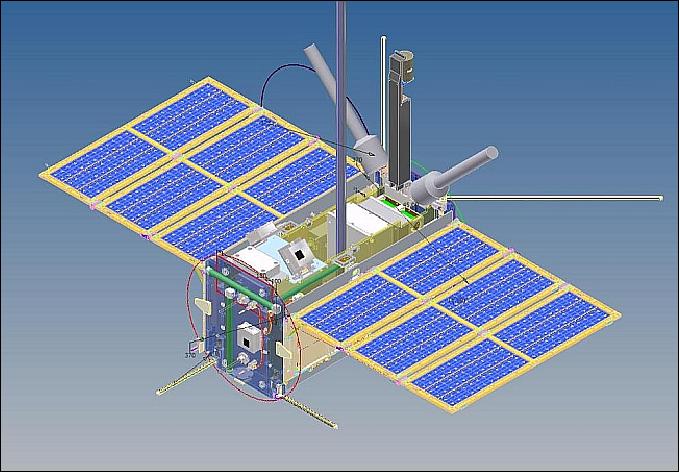
ADCS (Attitude Determination and Control Subsystem): Attitude sensing is provided by 5 digital sun sensors, a Honeywell magnetometer (HMR 2300R)and three single-axis angular velocity sensors (ADIS 16130). Actuation is provided by three mutually orthogonal magnetorquers and six reaction wheels. The magnetorquers are used to induce a controllable dipole magnetic moment. The reaction wheels are based on a brushless DC electric motor. The motor forces the wheel to accelerate or stop its rotation which results in the control torque. The torque value may be finely tuned according to the on-board computer commands, the torque direction is controlled by the proper distribution of the wheels rotation rates. The ADCS control unit is the main body of the system, linking sensors and actuators together and providing a feedback for the external control devices. The main tasks for the unit are the information collection and an analysis using attitude determination algorithms; processing attitude information to construct necessary control actions and passing all required information to the actuators in order to implement a torque. The pointing accuracy of the spacecraft is ±0.1-0.2º, while the angular velocity estimated error is 0.05º/s.. 10)
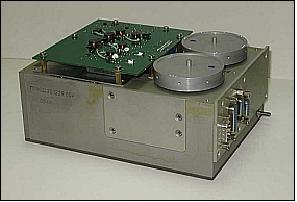
A combined GPS/GLONASS receiver provides the orbit and timing for the spacecraft. In addition, there is a gravity gradient boom for passive stabilization; however, the gravity boom is currently in stowed position, it will be used only as a backup passive stabilization system in case of a fly wheel failure.
Total mass of microsatellite at launch | 40 kg |
Mission design life | ≥ 2 years |
EPS (Electrical Power Subsystem) | 50 W (average power supply) |
Spacecraft stabilization | 3-axis stabilized + passive stabilization of the gravity gradient boom (when needed) |
ADCS | Use of GPS-GLONASS receiver for orbit and time provision |
RF communications: The TT&C data link (referred to as engineering channel) uses the VHF-band (145.435 MHz) in the uplink and the UHF-band (435 MHz) in the downlink at data rates of 9.6 kbit/s. The S-band (2.2 GHz) is used for the downlink of the payload data at rates of 128 kbit/s (1.2 Mbit/s max). The CCSDS packet telemetry protocol is being used. The on-board storage capacity is 0.5 GB. A volume of ~ 20 MByte/day of science data are being downlinked.
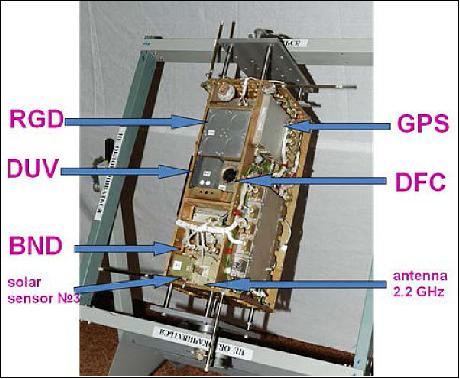
Launch
On Nov. 2, 2011, the Chibis microsatellite arrived at the ISS (International Space Station). It was part of the payload carried by the cargo service vehicle Progress M-13M (Russian ID, or Progress 45 (NASA ID). The Progress M-13M spacecraft lifted off from the Baikonur Cosmodrome in Kazakhstan on Oct. 30, 2011, starting with the 45th unmanned Russian space station resupply mission. The docking of Progress 45 marked the fully successful return of Progress operations to ISS after the loss of Progress 44 in August 2011. Progress 45 delivered 2800 kg of food, fuel and supplies to the space station, including the Chibis-M microsatellite.
The Chibis spacecraft is to be released and deployed on the return flight of Progress into a higher orbit than the one of ISS. After this event, the Progress vehicle will be directed to its predefined destination, namely the Pacific Ocean (Ref.19).
Final orbit of Chibis: Near-circular orbit (not sun-synchronous), altitude ~510 km, inclination = 52º.

Legend to Figure 5: The MS (Microsatellite) "Chibis-M" delivery to the orbit was carried out using the infrastructure of the Russian segment of the International space station (RS ISS). The TLC (Transport and Launch Container) with Chibis-M was installed in the TCV of Progress M-13M". Before undocking of the TCV from the ISS, Russian cosmonauts O. Kononenko and A. Shkaplerov connected the TCV cable system to the "Chibis-M" battery charger and the command line to actuate the electrical mechanism of "Chibis-M" evacuation from the TCV and fixed appropriately the TLC with MS "Chibis-M" in the "Progress M-13M" docking compartment.
After separation from the ISS, the TLC Progress M-13M, according to a special program, made a maneuver to raise its orbit up to an altitude of 513 km. An important step was the organization of specialists of RSC Energia television broadcast in real-time to demonstrate the release of the Chibis-M from the TCV and its separation from the Progress M-13M. The separation time was calculated so that it was at sunlight part of the orbit. This provided good broadcast conditions of the television scene from the "Progress M-13M", which lasted 9 minutes and was transferred in real-time to the ISS Control Center. Also it was very important to make sure that all MS systems (solar panels, antenna and sensors array) were opened.
This launch procedure was realized January 25, 2012 (on the Progress-13M return flight) and the Chibis-M was inserted in the orbit with an altitude 513 km and an inclination of ~52º. Then the IKI RAN flight control team established a command and telemetry link with the "Chibis-M" and started the operation of service systems (Ref. 12).
Mission Status
• April/May 2015: The experiment was conducted in the interests of fundamental space research and was exploratory in nature, expecting to shed light at still unknown spectral and energy characteristics of electromagnetic radiation in the ionosphere (at altitudes of 350 - 400 km) during powerful high-altitude thunderstorms. During ~3 years in orbit, the microsatellite "Chibis-M" registered several hundreds events associated with short (from tens of microseconds to hundreds of milliseconds) and powerful (hundreds of joules) lightning discharges, recorded radiation in a wide electromagnetic spectrum from the ELF/VLF, HF, ultraviolet and infrared ranges to x-ray and gamma-ray bursts. One of the examples of the registered powerful microsecond VHF pulses is shown on Figure 6. These pulses were generated as a result of a runaway breakdown, accompanied by repeated pulses, which is a reflection from the surface of the Earth. 11)
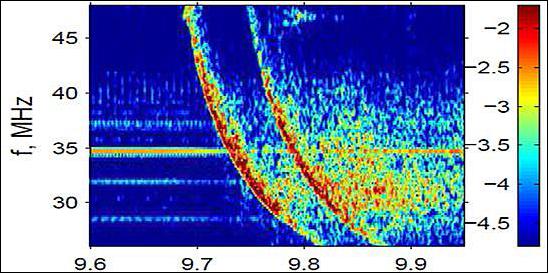
- In particular, a large amount of data was obtained in the range of ELF/VLF emissions, both in quiet and disturbed geomagnetic conditions, characterized by a high dynamic range and high spectral resolution. They highlighted the specific characteristics of a number of ionosphere-magnetosphere resonances.
An interesting result is illustrated in Figure 7, where, quite unexpectedly, during the flight over Japanese territory, the intensive radiation of ground-based power lines at frequency – both 50 and 60 Hz, which are present in Japan - was detected by the "Chibis-M" electric channel. Also the Schumann resonance modes are clearly seen in this figure. Both of these events are, most probably, due to the leakage of ULF signals from the thermosphere, against existing theory, in the ionosphere above the F2 layer. This effect was observed regularly in the 50(60) Hz frequency band both at day and night sides of the orbit and only for the night parts of the orbit for Schumann resonances. The electric field channel of the MWC provided the measurement of one electric field component perpendicular to the orbital plane in the frequency range of 0.1-40,000 Hz. In spite that an electric dipole had a very short baseline (42 cm only), it demonstrated low enough noise spectral density: 0.8-0.04 (µV/m)/√Hz.
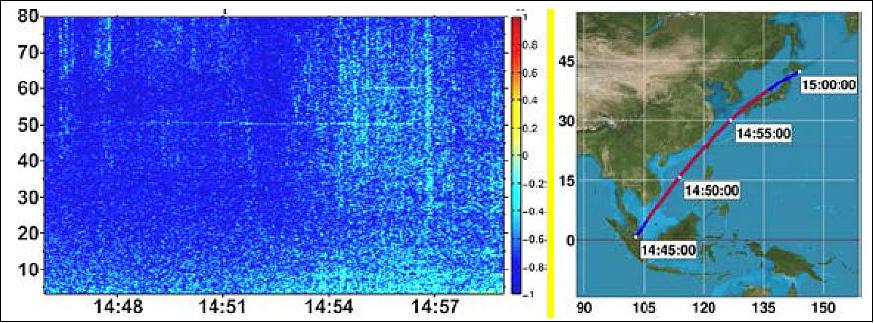
- Such high sensitivity of the electric channel allowed also regular registering of still one phenomenon in the upper ionosphere — low-frequency electromagnetic structures excited by atmospheric thunderstorm activity in the IAR (Ionospheric Alfven Resonator) frequencies from about 0.5 Hz to ~ 5 Hz. An example of such signal detection is shown in Figure 8.

- These results were obtained for the second time in world space research. In the first time, they were found in the data of the US C/NOFS (Communication/Navigation Outage Forecast System) satellite of DoD and NASA, which had an electric field channel baselength 20 m, but only within orbital latitudes of ±13º, whereas "Chibis-M" collected the data within the latitude range of ±52º, this allowed a more generalization of the results from the equatorial zone to a much wider coverage band.
• October 2014: Chibis-M, deployed from the transportation vehicle Progress M-13M on 25 January 2012 (on its return flight from the ISS), successfully worked in its elevated orbit for 2 years and 8 months (design life of 1 year). On Oct. 15, 2014, the Chibis-M spacecraft reentered the dense layers of Earth's atmosphere and disintegrated at 17:57 UTC (Ref. 15). 12)
- The Chibis project conducted the last session with Chibis-M on October 14, 2014 when all systems were operating nominally.
- IKI and the other team members will continue their research on the Russian segment of the ISS including the development of two new microsatellites: "Chibis-AI" - to continue studies lightning and "Trabant" for the study of electromagnetic coupling in the lithosphere-atmosphere-ionosphere system.
• The Chibis-M mission is operating nominally in February 2014. The Chibis-M microsatellite is on orbit as a free-flyer since January 25, 2012. During this time, about 2000 contacts were made with the spacecraft; approximately 300 contact periods were used to download the data of the Groza equipment, totaling ~30 GB. 15)
The map of Figure 9 is derived from data of the RFA (Radio Frequency Analyzer) device onboard the microsatellite "Chibis-M". The points marked on the map represent instrument response characteristic radio emissions of lightning events in the 26-48 MHz range. The highlighted areas with the highest number of events, which are in good agreement with the known regions of high lightning activity, occur primarily in the equatorial latitudes.
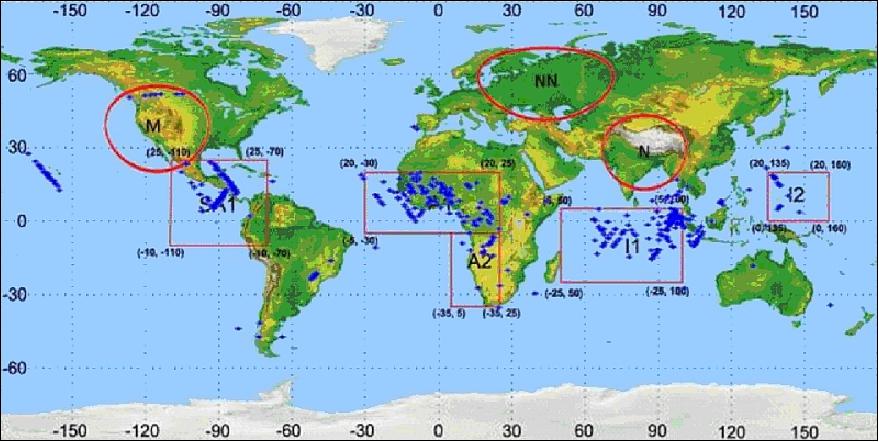
The RFA device data provide not only scientific information, but are also being used as a "trigger" for the other instruments on board the microsatellite: a signal received from the RFA switch in the data recording process from the instruments operating in other range of the electromagnetic radiation. Together, they represent the "bulk" image atmospheric lightning discharge in the visible, ultraviolet, X-ray and gamma-ray and ultra-low frequency range where the manifest magnetic ripple effects of electrical activity in the ionosphere.
• The Chibis-M mission is operating nominally in 2013. 16)
• In the summer of 2012, the Chibis-M is in nominal flight operations.
• Mission operations of the Chibis-M microsatellite are planned to be started in March 2012, after all systems have been tested (Ref. 19).
• On January 25, 2012 ,the microsatellite Chibis (lapwing) was successfully deployed from the transportation vehicle Progress M-13M and started its own mission.
• The new orbit parameters are: perigee = 497 km, apogee = 513 km, inclination = 51.6°, period = 94.55 minutes. The telemetry information confirmed that all onboard systems are working. The size of the microsatellite with open solar panels and antenna is 1.2 m x 1 m. 17)
• On January 24, 2012, the Progress M-13M space freighter with the Chibis-M microsatellite undocked from the ISS Pirs docking module as scheduled, in an automated mode. Thereafter, Russian controllers started the propulsion engines and brought Progress M-13M into an orbit of ~ 500 km altitude (including two orbit corrections). The Chibis-M microsatellite was deployed on January 25, 2012 from the space freighter and will remain in orbit for at least four years studying lightnings and thunderstorms in the Earth's atmosphere. 18)
• Progress M-13M is planned to remain docked to the Space Station for nearly three months. It will undock from the Pirs Nadir port in late January 2012 and will raise the Chibis microsatellite to the pre-designed near-circular orbit of 480 km altitude, inclination ~52º. Then Chibis-M will be deployed and will begin its own mission in space. 19)
Mission Results
During ~3 years on orbit, the microsatellite "Chibis-M" registered several hundred events associated with short (from tens of microseconds to hundreds of milliseconds) and powerful (hundreds of joules) lightning discharges, recorded in a wide electromagnetic spectrum of radiation from the ELF/VLF radio, ultraviolet and infrared ranges to X-ray and gamma-ray bursts. Data on ELF/VLF emissions in the quiet and disturbed geomagnetic conditions, characterized by a high dynamic range and high spectral resolution, highlight the specific characteristics of a number of ionosphere-magnetosphere resonances. 13) 14)
An interesting result was obtained, quite unexpectedly, from the very short baseline (42 cm only) electric field channel of the MWS, which provided the measurement of one electric field component perpendicular to the orbital plane in the frequency range of 0.1-40,000 Hz with the noise spectral density 0.8-0.04 (µV/m)/√Hz (in the band 1-100 Hz the noise is 0.2-0.04 (µV/m)/√Hz). In the experimental data, the intensive radiation of ground-based power lines at the main frequency 50(60) Hz was detected, both at day and night phases of the orbit which leaked, against existing theory, into the ionosphere above the F2 layer. By this, the power line localization was clearly identified by the signal maximum at the Chibis-M orbit crossing of this line.
Also, the Schumann resonance modes (up to 11th harmonics) were observed, but exclusively in the night side orbit phase, which also leaked above the F2 layer. These data were obtained for the second time in world space research; for the first time, they were shown in the results of C/NOFS (Communication/Navigation Outage Forecast System)) satellite mission of DoD and NASA (launch April 16, 2008), which had an electric field channel baselength of 20 m, but only within latitudes ±13º, whereas Chibis-M collected the data within the latitudes ±52º, what allowed the results generalization from equatorial zone to a much wider coverage.
As a result of implementation of the project "Chibis-M" the following scientific and methodological results were received:
a) For the first time the full cycle of development, production, and ground testing of a microsatellite platform for fundamental space research in academic institution was successfully processed.
b) The specialized set of scientific payload "Groza" was created
c) The procedure of a microsatellites inserting into an orbit to the heights of ~ 500 km, using the infrastructure of the Russian segment of the ISS was realized.
d) The operation period of Chibis-M exceeded about 3 times the scheduled term without the use of space qualified components.
e) The ground segment equipment, developed by IKI, reliably assured the Chibis-M microsatellite operation in orbit, the implementation of the scientific program, reception and initial processing of scientific information (~ 30 GB), transfer of scientific information to the participants of the experiment, including international partners.
f) The experimental data allowed to obtain new scientifically sound results, both as to the discrete fractal properties of the charge distribution, and the percolation effects of the flow discharge in an inhomogeneous turbulent environment in storm clouds, which previously paid little attention in the study of atmospheric electricity and mechanisms of generation of high-power TGFs (Terrestrial Gamma-ray Flashes) , and independent low-frequency phenomena in the ionosphere. 12) 13) 14)
Sensor Complement (Groza, KNA Groza)
Instrument/Item | Parameter | Institution |
RGD (Roentgen & Gamma ray Detector) | - X-ray energy range: 50-500 keV | SINP |
DUV (UV Detector) | - Emission wavelength: 300-450 nm | SINP |
DPC (Digital Photo Camera) | - Info matrix: 1000 x 1000 pixels, 10 bit | IKI |
RFA (Radio Frequency Analyzer) | - Dipole electric aerial | IKI |
KNA Groza [ULF/VLF Wave Package (WP)] | - E and B sensors in the range of 0.1 Hz - 40 Hz | LC-ISR, SRG |
Data acquisition system | - Operative memory (5-10 cycles): 1..75-3.5 Gbit | IKI |
• The fact of registration of the lightning discharge ("event") is to develop the "Groza" single trigger events based on coincidence triggers physical devices. Algorithms for generating these triggers are based on models of the physical mechanisms of lightning (Ref. 12).
• For the first time comprehensive studies were conducted in the altitude range of 250 - 500 km of ultraviolet (UV) and infrared (IR) radiation, gamma rays, radio and ELF / VLF emissions in thunderstorm formations.
• For the first time simultaneously recorded signals in the UV and IR regions of the optical spectrum and radio emission in the range of 26-48 MHz. These data are necessary for the correlation analysis of the electric field and the efficiency of the plasma glow discharge of lightning.
• Registered powerful microsecond VHF pulses - the result of runaway breakdown, which, more often, accompanied by repeated pulses, which is a reflection of the first surface of the Earth. The interval between the first and second pulses to determine the height of the discharge order of 10 km.
• Proved the existence in the upper ionosphere of low-frequency electromagnetic structures, excited by atmospheric thunderstorm activity: ionospheric Alfven resonator (frequency of about 0.5 Hz to ~ 5 Hz) and the Schumann resonance (~ 8 Hz frequency and harmonics).

Scientific Payload Groza
The scientific payload of the Chibis-M, designed for the study of new physical processes at high-altitude atmospheric lightning discharges, includes: 20)
• RGD (X-ray and Gamma-ray Detector) with a 0.02-1.0 MeV energy band
• DUV (Ultraviolet Detector) of radiation with wavelengths from the UV (180-400 nm) to IR (650-800 nm)
• RFA (Radio Frequency Analyzer) in the frequency range 26 - 48 MHz
• CFK (Digital Camera) with a spatial resolution of 300 m and the exposure time of 15 frames/s
• MWC (Magnetic Wave Complex) in the frequency range of 1 - 40,000 Hz
• BND (Data Acquisition Unit).
Each instrument of Groza has a ring memory (RM) with a fixed size sufficient to record a few events. The total size of the memory of the instrument is determined by the maximum duration of the event, which is set for each instrument by the PI of the experiment. The duration of the record can be controlled by ground commands. For example, the RFA can provide registration time 50 ms, RGD - 20 ms, DUV - 100 ms. Other digitization parameters also can be set by command from the Earth: the period of sampling (sampling time), the criterion of "event" or trigger of the instrument (Ti), the size of saved memory "before" and "after" the event. Due to the accidental nature of the events, the project is interested in the record in the RM which is connected to the on-board time forming the identity array of the event (header, number, etc.), Figure 11. Only the records matching the Ti criterion are stored in RM. If no event was identified, the next loop of recording is carried out.

The logic of the Groza operation is illustrated below in the example of the RGD instrument intended to record sporadic outbursts (bursts) of the hard X-ray and gamma-ray at high-altitude atmospheric discharges. Four gamma-ray scintillators are used, which are based on crystals of NaI(Tl) with a diameter of 5 cm and a thickness of 1.0 and 2.0 cm. In the course of the experiment, the permanent recording of the RGD readings is carried out. The output of the detectors providing the time profile of the burst is digitized with a resolution of less than 100 ns and recorded during a time interval that is set by the internal RM resources (not less than 20 ms) and is further overwritten with the subsequent set of readings. Thus, the RM always keeps the current sequence of digitized detector readings of the last 20 ms. Along with the recording of the digitized signals from each of the 4 detectors, the number of counts (with a signal amplitude exceeding a threshold corresponding to the energy release in the detector 25 keV) is accumulated over the interval of 3 ms and over the interval of 1 s (optionally) prior to the interval of 3 ms. By summing up the counts at each detector channel during 1 s interval prior to 3 ms, one can determine the background level. The excess of counts summed over 3 ms over the background level for a certain number of "sigma" in a predefined number of detectors (the number of "sigma" and the number of detectors are set by ground command, the default value - 3σ for at least two detectors) is a sign of the event.
The Scientific Committee of the project has acknowledged that the best option for lightning strikes registration at the first stage would be such when the Tc is initiated with the Ti of RFA, the latter being the highest sampling speed instrument that measures the intensity of radio emissions in a typical lightning range of 26-48 MHz. The instrument includes a spectrum analyzer with five broadband filters, evenly spaced over the operating range. At the output of each filter a set of threshold elements and the majority scheme of signal enrollment (precision of trigger binding to the board time is 1 µs) are mounted. After the Ti receiving a radio signal over a time period, defined by a ground command, is recorded in the RM, Figure 12. In this case, the moment of the Ti receiving is in the middle of the selected time interval. The Ti can be used by other MS instruments to record likely lightning discharge at the same moment as the RFA in the ultraviolet, infrared, gamma radiation and ELF frequency ranges.
During its operation, the RFA has identified areas of the most intense man-made interference and most promising areas for the registration of lightning activity. The RFA operation schedule is planned now with taking these zones into account. For the past eight months of satellite operation in 2012 several hundred triggers were recorded with more than a hundred of them associated with short and powerful lightning. Figure 12 demonstrates examples of the RFA waveform recordings of lightning discharges possessing different appearances. They show gradual increase of electromagnetic activity ending by a single powerful short radio pulse and subsequent decay of the field, or multiple short discharges, following with an intervals of 50-100 µs during about 1 ms, or increased storm activity during 400 µs without discharges at all.
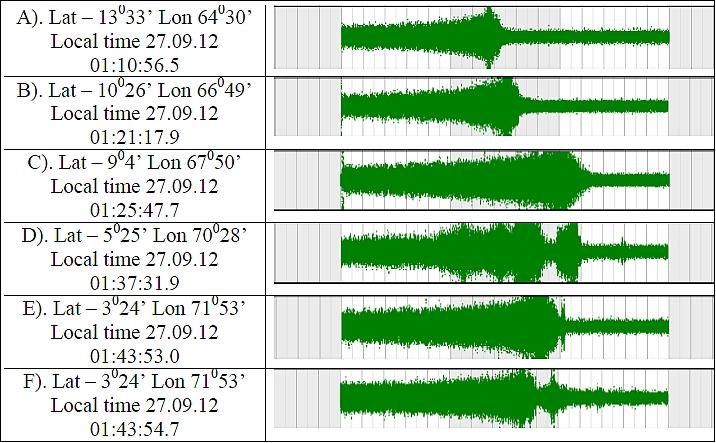
Chibis-M is able to effectively monitor electromagnetic environment of the Earth at ionospheric altitudes producing simultaneous measurements of electromagnetic emissions in a very broad frequency band from VLF and VHF to X- and gamma-rays. Special technique of trigger formation makes it possible to prevent uncontrollable expanding of the amount of data stored. Recordings of VLF electromagnetic fields conducted by Chibis-M are believed to be relevant to natural processes in the ionosphere and the magnetosphere of Earth, in the first place to lightning activity what was proved with primary analysis of received data (Ref. 20).
KNA Groza (Wave Probe)
The objective of KNA Groza is the study of the process of the development of the stepped leader of high-altitude lightning in high electric fields.
The Wave Probe (WP) device is a combination of three sensors in one module: SLP (Split Langmuir Probe), search-coil magnetometer, and electric probe. The Wave Probe instrument was already successfully tested in the spatial experiment VARIANT onboard the Ukrainian SICH-1M satellite (launch Dec. 4, 2004).
Frequency range for all channels | 0.1 - 40,000 Hz |
Dynamic range | 120 dB |
Noise level of measuring channels at 1 kHz | - Electric current density channel: ≤ 10-13 A/cm-2 Hz-1/2 |
Current density transformation factor | 77 V/mA/cm2 |
Magnetic induction transformation factor | 100 mV/nT |
Power consumption | < 0.25 W |
Instrument size | - Sensor: 24 mm diameter, x 294 mm |
Instrument mass | - Sensor: 0.225 kg |
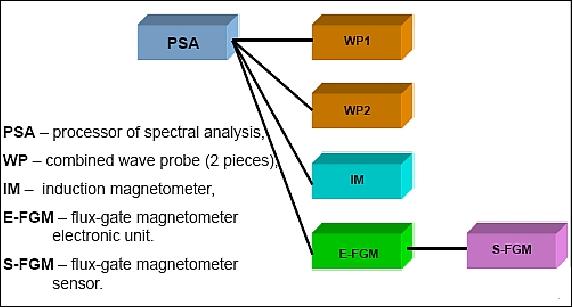
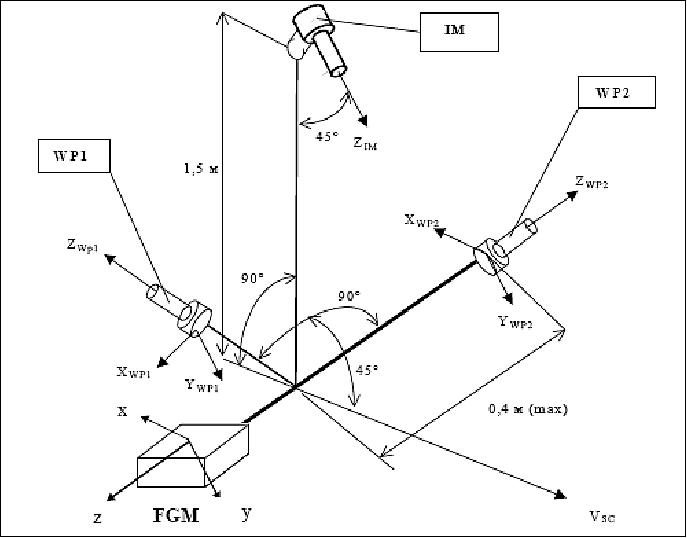

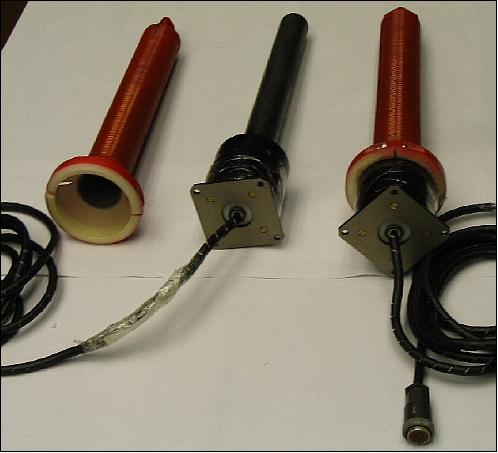
Event Processing
The PSA (Programmable Signal Analyzer) provides event processing of the payload strobe for the fixation at lightning discharge occurrence of EM radiation generation in the UHF/VLF (2 x 104 to 10-2 Hz) range. The EMR generated in the basic phase of the lightning discharge, called whistles, are recorded in the VLF frequency range. The main task is the measurement of the EM fluctuations in the range of frequencies 0.1Hz - 40 kHz.
Sensor | Computer No | Bandwidth | Sampling speed (max) |
Search coil (Bx, By, Bz) | 3 | 0.1 Hz-40 kHz | 100 kHz |
Electric VLF (E=E2-E1) | 1 | 0.1 Hz-40 kHz | 100 kHz |
Plasma current (I1, I2) | 2 | 0.1 Hz-40 kHz | 100 kHz |
Electric ULF (E=E2-E1) | 1 | DC-100 Hz | 250 Hz |
Magnetometer (BMx, BMy, BMz) | 3 | DC-100 Hz | 25 Hz |
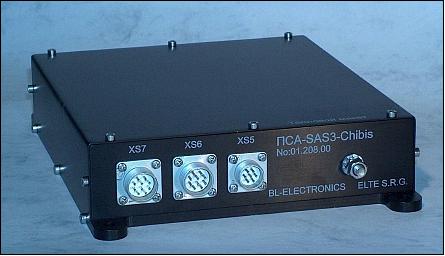

The magnetic - wave experiment is aimed also at the study of the interrelation of plasma - wave processes in the ionosphere, which take place during the sun - magnetosphere - ionosphere - atmosphere interactions and is of great interest for studying the parameters of space weather. It is expected that the systematic study of these connections will make it possible to find the universal laws, which regulate conversion and dissipation of plasma - wave energy in the magnetosphere - ionosphere system.
The FM (Fluxgate Magnetometer) will be included in the WP. This is a newly developed low mass and low-power but highly sensitive device, especially designed for micro- and nanosatellites. Its parameters are (parameters are specified for all three analogue outputs):
Field measurement range | ± 64 000 nT |
Transformation factor | 64 ± 0.6 (µV/nT) |
Frequency range | DC to 10 Hz |
Noise level at 1 Hz | ≤ 10 pT Hz-1/2 |
Power consumption | < 0.5 W |
Electronic unit dimensions | 150 mm x 85 mm x 40 mm |
Sensor mass | < 0.1 kg |

Full frequency band of received signal | 1 Hz-20 kHz |
Frequency characteristics flat part of pass band | 1-20 kHz |
Transformation factor | 100 mV/nT |
Output parameters | - Output voltage (max): ±5 V |
Magnetic noise level | @ 10 Hz: ≤ 2 pT Hz-1/2 |
Power consumption | ≤ 25 mW |
Temperature range | - Operations mode: ±50ºC |
Outer dimensions of instrument | Length: 211 mm, diameter: ≤ 25 mm |

603Frequency range for all channels | 0.1 Hz to 40 kHz |
Dynamic range | 120 dB |
Noise level of measuring channels @ 1 kHz | - Electric current density channel: ≤ 10-13 A cm-2 Hz-1/2 |
Current density transformation factor | 77 V/mA/cm2 |
Magnetic induction transformation factor | 100 mV/nT |
Temperature range | ± 50ºC |
Power consumption | < 0.25 W |
Device dimensions | Sensor: 24 mm diameter |
Device mass | Sensor: 0.225 kg |
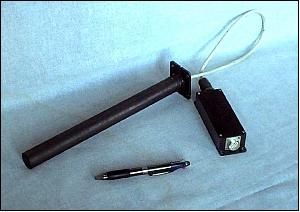
Ground Segment
The project uses a few ground stations in Russia. The main station is located in Tarusa (Russia). It provides facilities for both engineering and scientific channels. The spare station for engineering channel is provided in Kaluga (Russia), and a spare station for science data is located in Panska Ves (Czech Republic). 21) 22)
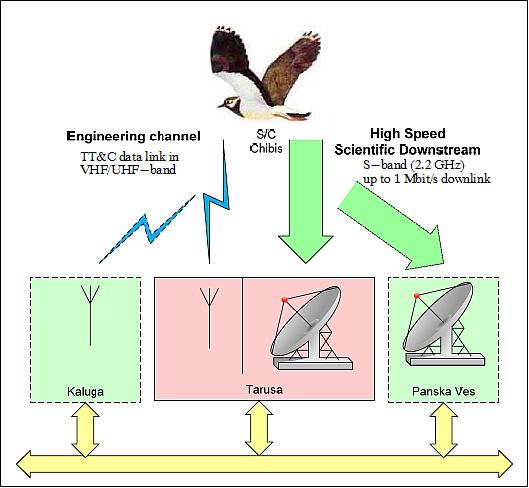
The nature of the low-cost mission requires that all nodes of the ground segment (stations, processing centers, operations centers, workstations of investigators) are being linked by public internet facilities.
The main node of the ground system is located at IKI of Moscow, providing the functions of MOC (Mission Operations Center) and DPDC (Data Processing and Distribution Center). Other organizations such as telemetry stations, SINP MSU (Skobeltsyn Institute of Nuclear Physics of Moscow State University) and LPI RAN (Lebedev Physical Institute of the Russian Academy of Sciences) interconnect through the main node.

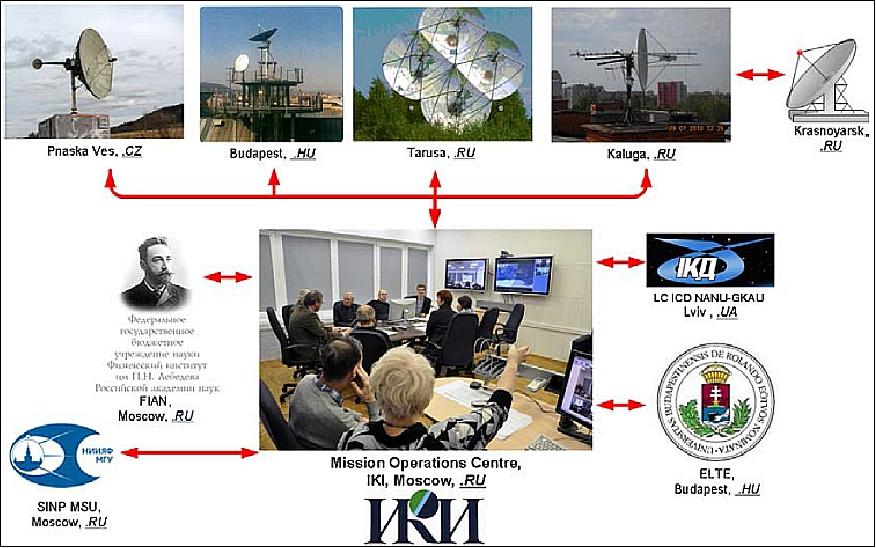
Ground-based Observations
Ground-based observations coordinated with the Chibis-M mission are to be performed by institutions in the following countries:
• Russia (Caucasus observatory, Yakutsk Lightning Monitoring System)
• Europe (Eurosprite network - France, Spain, Hungary, Greece)
• Israel (Tel Aviv University)
• USA (Stanford University, Duke University)
• Brazil (Instituto Nacional de Pesquisas Espacias)
• New Zealand (WWLLN Network)
• India (Institute of Geomagnetism)
• Japan (Hokkaido University)
Theoretical and modeling efforts in support of the data analysis are to be provided by:
• European centers (Eindhoven University, )
• Russian centers (Lebedev Institute of Physics, Institute of the Physics of the Earth, N. Novgorod University).
References
1) Stanislav Klimov, Denis Novikov, Valeriy Korepanov, Andriy Marussenkov, Csaba Ferencz, Janos Lichtenberger, Laszlo Bodnar, "The Study of Electromagnetic Parameters of Space Weather. Micro-Satellite Chibis-M," Proceedings of the 7th IAA Symposium on Small Satellites for Earth Observation, Berlin, Germany, May 4-7, 2009
2) V. N. Angarov, G. K. Garipov, V. M.Gotlib, A V.; Gurevich, S. I. Klimov, V. G. Rodin, S. I. Svertilov, L. M. Zelenyi, "Investigation of new physical phenomena in the atmospheric lightning discharges: Micro-satellite CHIBIS-M," Proceedings of the 7th IAA Symposium on Small Satellites for Earth Observation, Berlin, Germany, May 4-7, 2009, IAA-B7-0214P
3) S. I. Klimov, L. M. Zelenyi, D. I. Novikov, Cs. Ferencz, J. Lichtenberger, L. Bodnar, V. E. Korepanov, A. A. Marusenkov, "Electromagnetic Parameters Study for Space Weather Research (Microsatellite "Chibis-M")," Proceedings of the AGU Chapman Conference on the Effects of Thunderstorms and Lightning in the Upper Atmosphere, Penn State, College Park, PA, USA, May 10-14, 2009
4) L. M. Zelenyi, V. G. Rodin, V. N. Angarov, T. K Breus, M. B. Dobriyan, S. I. Klimov, O. I. Korablev, V. E. Korepanov, V. M. Linkin, E. A. Loupian, N. N. Ivanov, L. E. Lopatento, O. Yu. Sedykh, "Micro-satellite "Chibis" – universal platform for development of methods of space monitoring of potentially dangerous and catastrophic phenomena.," Proceedings of the 5th International Symposium of the International Academy of Astronautics (IAA), Berlin, Germany, April 4-8, 2005, URL: http://www.dlr.de/iaa.symp/Portaldata/49/Resources/dokumente/archiv5/1502_Klimov.pdf
5) V. Korepanov, A. Marusenkov, S. Belyayev, S. Klimov, L. Zelenyi, D. Novikov, Cs. Ferencz, J. Lichtenberger, L. Bodnar, "Earth Observation Microsatellite Chibis," Proceedings of the 60th IAC (International Astronautical Congress), Daejeon, Korea, Oct. 12-16, 2009, IAC-09.B1.1.11
6) V. Pilipenko, "New physical phenomena in the atmospheric lightning discharges: observations from microsatellites and ground," FP7-SPACE-2010-1, URL: http://7pr.kpk.gov.pl/pliki/10346
/Pilipenko_New_physical_phenomena_in_the_atmospheric_lightning_discharges.pdf
7) L. M.Zelenyi, S. I.Klimov, A. A.Petrukovich, "International experiments of the Russian Academy of Sciences in the frame of the Space Weather Program," The Scientific & Technical Subcommittee of the COPUOS (Committee on the Peaceful Uses of Outer Space) 2010, 47th session, Vienna, Austria, February 8-19, 2010, URL: http://www.oosa.unvienna.org/pdf/pres/stsc2010/tech-11.pdf
8) "Microsatellite attitude control system," ScanEx RDC, URL: http://www.scanex.ru/en/acs/default.asp?submenu=orientation&id=idescription
9) Information provided by Stanislav Karpenko of Sputnix LLC, Moscow, Russia
10) M. Yu. Ovchinnikov, D. S. Ivanov, N. A. Ivlev, S. O. Karpenko, D. S. Roldugin, S. S. Tkachev, "Chibis-M Microsatellite ACS Development, Complex Investigation, Laboratory and Flight Testing," Proceedings of the 9th IAA Symposium on Small Satellites for Earth Observation, Berlin, Germany, April 8-12, 2013, paper: IAA-B9-1216P
11) S. I. Klimov, L. M. Zeleyi, V. N. Angarov, V. N. Nazarov, V. M. Gotlib, N. A. Eismont, M. S. Dolgonosov, V. N. Karedin, D. I. Novikov, D.L. Vavilov, M. I. Pansayuk, V. E. Korepanov, D. F. Dudkin, Cs. Fernecz, P. Szegedi, "Microsatellite "Chibis-M" (25.01.2012 – 15.10.2014). Results, lessons and prospects," 10th IAA Symposium on Small Satellites for Earth Observation, Berlin, Germany, April 20-24, 2015, paper: IAA-B10-0808P, URL of presentation: http://www.dlr.de/iaa.symp/Portaldata/49/Resources/dokumente/archiv10/pdf/0403_0808P.pdf
12) S. I. Klimov, L. M. Zeleyi, V. N. Angarov, V. N. Nazarov, V. M. Gotlib, N. A. Eismont, M. S. Dolgonosov, V. N. Karedin, D. I. Novikov, D.L. Vavilov, M. I. Pansayuk, V. E. Korepanov, D. F. Dudkin, A. M. Marusenkov, Cs. Fernecz, P. Szegedi, "Microsatellite "Chibis-M" (25.01.2012 – 15.10.2014) Results, lessons and prospects," 10th IAA Symposium on Small Satellites for Earth Observation, Berlin, Germany, April 20-24, 2015, paper: IAA-B10-0808P, URL of presentation: http://www.dlr.de/iaa.symp/Portaldata/49/Resources/dokumente/archiv10/pdf/0403_0808P.pdf
13) Stanislav Klimov, Csaba Ferencz, Laszlo Bodnar, Peter Szegedi, Peter Steinbach, Vladimir Gotlib, Denis Novikov, Serhiy Belyayev, Andrey Marusenkov, Orsolya Ferencz, Valery Korepanov, Janos Lichtenberger, Daniel Hamar, " First results of MWC SAS3 electromagnetic wave experiment on board of the Chibis-M satellite," Advances in Space Research, Vol. 54 (2014),pp: 1717–1731
14) D. Dudkin, V. Pilipenko, V. Korepanov, S. Klimov, R. Holzworth, " Electric field signatures of the IAR and Schumann resonance in the upper ionosphere detected by Chibis-M microsatellite," Journal of Atmospheric and Solar-Terrestrial Physics, Vol. 117, (2014) pp: 81–87
15) The information was provided by Stanislav I. Klimov of IKI (Space Research Institute), Moscow.
16) Igor Afanasyev , "Open source smallsats in Russia," The Space Review, January 7, 2013, URL: http://www.thespacereview.com/article/2213/1
17) Information letter N2 "Project Chibis" received on January 26, 2012 from Viacheslav Pilipenko of IKI (Space Research Institute), Moscow, URL: http://chibis.cosmos.ru/index.php?id=1671&tx_ttnews[tt_news]=2667&cHash=b5453ccfa30964a8230f766622b7f79d
18) "Progress Space Freighter Undocks from ISS," Space Travel, Jan. 25. 2012, URL: http://www.space-travel.com/reports/Progress_Space_Freighter_Undocks_from_ISS_999.html
19) Information letter "Project Chibis" received on January 17, 2012 from Viacheslav Pilipenko of IKI (Space Research Institute), Moscow
20) S. I. Klimov, V. M. Gotlib., L. M. Zelenyi, V. N. Karedin, V. M. Kozlov, I. V. Kozlov, D. I. Vavilov, M. S. Dolgonosov, G. K. Garipov, S. I. Svertilov, V. V. Bogomolov, I. V. Yashin, V. E. Korepanov, L.Bodnar, Cs. Ferenz, "Algorithm of the formation of high altitude atmospheric lightning trigger testing -Academic microsatellite Chibis-M," Proceedings of the 9th IAA Symposium on Small Satellites for Earth Observation, Berlin, Germany, April 8-12, 2013, paper:IAA-B9.0501
21) V. Nazarov, R. Nazirov, V. Gotlib, O. Batanov, N. Eismont, V. Karedin, F. Korotkov, A. Ledkov, Ya. Markov, A. Melnik, A. Tretiyakov, A. Popkov, S. Svertilov, "Low-cost ground segment for Russian Academia-University science space missions," Proceedings of SpaceOps 2012, The 12th International Conference on Space Operations, Stockholm, Sweden, June 11-15, 2012, URL: http://www.spaceops2012.org
/proceedings/documents/id1293615-Paper-003.pdf
22) V. Angarov, N. Eismont, V. Gotlib, V. Kozlov, V. Nazarov, R. Nazirov, V. Rodin, "Ground segment of low budget satellite Chibis," Proceedings of the 7th IAA Symposium on Small Satellites for Earth Observation, Berlin, Germany, May 4-7, 2009, IAA-B7-0215P
23) V.Nazarov, R.Nazirov, L.Zelenyi, V.Angarov, O.Batanov, L.Bodnar, N.Eismont, V.Gotlib, V.Karedin, S.Klimov, F.Korotkov, I.Kozlov, A.Ledkov, A.Melnik, A.Papkov, V.Rodin, A.Ryabova, Ya.Shmelauer, A.Tretiakov, "Ground segment and operations for microsatellite Chibis-M: learned lessons, current status and prospective evolutions," Proceedings of the 9th IAA Symposium on Small Satellites for Earth Observation, Berlin, Germany, April 8-12, 2013, paper: IAA-B9-0802
The information compiled and edited in this article was provided by Herbert J. Kramer from his documentation of: "Observation of the Earth and Its Environment: Survey of Missions and Sensors" (Springer Verlag) as well as many other sources after the publication of the 4th edition in 2002. - Comments and corrections to this article are always welcome for further updates (eoportal@symbios.space).
Overview Spacecraft Launch Mission Status Sensor Complement Ground Segment References Back to top